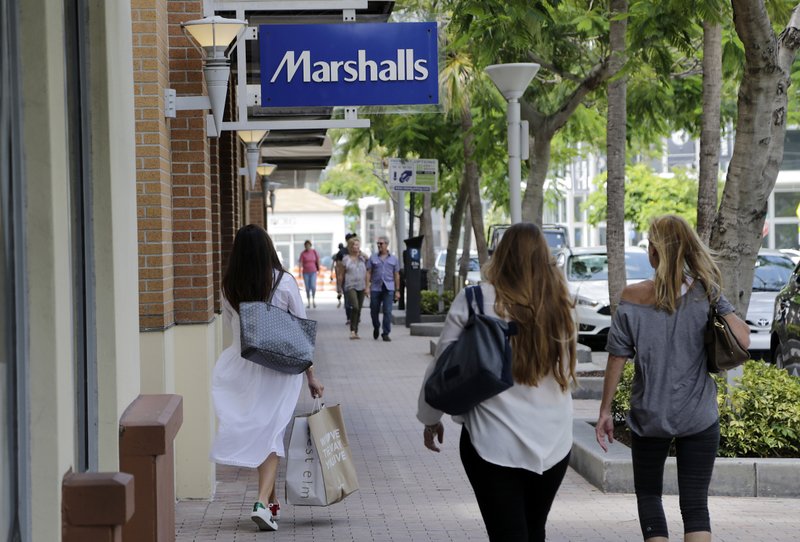WASHINGTON -- Consumer spending slowed in June as income growth turned in the weakest performance in seven months, the Commerce Department reported Tuesday.
Spending edged up a tiny 0.1 percent, compared with a 0.2 percent rise in May. It was the weakest showing since spending increased a similar 0.1 percent in February. Incomes were flat in June after a 0.3 percent rise in May. It was the worst reading since incomes fell 0.1 percent in November.
Spending is closely watched because it accounts for 70 percent of economic activity. Even with the weakness in June, spending for the April-June quarter revived, helping to lift overall economic growth to a solid rate of 2.6 percent during the quarter. Economists believe solid job growth will keep economic growth at healthy levels this quarter.
Andrew Hunter, a U.S. economist with Capital Economics, said the new report showed that consumer spending had lost some momentum at the end of the second quarter, "which isn't a particularly promising sign going into the third quarter."
The slowdown in income growth reflected declines in dividend and interest payments and other investment income. The key category of wages and salaries actually rose a solid 0.4 percent in June, reflecting strong employment growth during the month.
An inflation gauge tied to consumer spending that is closely followed by the Federal Reserve was up 1.4 percent for the 12 months ending in June, compared with a 1.5 percent increase in May. It was the smallest 12-month gain since September and showed that inflation is continuing to fall further from the Fed's target for prices to be rising by 2 percent annually.
The central bank left its key interest rate unchanged at a meeting last week after raising the rate in March and June. Some economists believe the Fed will not raise the rate again this year unless inflation resumes rising toward the Fed's 2 percent target.
Many economists believe the slowdown in inflation will at least keep the Fed on hold at its next meeting in September. But Hunter said he still expects one more rate increase this year, probably in December, prompted by further declines in the unemployment rate, which already is at a low 4.4 percent.
With incomes flat and spending showing a tiny gain, saving slipped to 3.8 percent of after-tax income, down from 3.9 percent in May.
The 2.6 percent in overall growth, as measured by the gross domestic product, in the second quarter was more than double the lackluster 1.2 percent gain in the first quarter.
U.S. construction spending declined in June for the second time in three months, as spending on government construction projects plunged by the most in 15 years.
Construction spending fell 1.3 percent in June, the biggest drop since a 1.8 decline in April, the Commerce Department reported Tuesday. Spending rose a tiny 0.3 percent in May.
The decline raises concerns that construction may not provide as much support for the overall economy as had been expected in the second half of the year.
The only positive reading in June was in nonresidential construction, which ticked up 0.1 percent.
Home construction declined 0.2 percent, the third consecutive decrease in that category. Government spending fell 5.4 percent, the biggest drop since a 6 percent decline in March 2002.
The 0.1 percent rise in nonresidential construction follows a 0.6 percent increase in May, with both gains following several months of declines. The gain in June was helped by a strong 2.9 percent increase in spending on office construction, which offset a 0.4 percent decline in the category that includes shopping centers.
Overall spending was reported at a seasonally adjusted annual rate of $1.21 trillion, compared with last month's revised figure of $1.22 trillion.
American manufacturers turned in another solid month in July amid steady growth in production, orders and employment, according to figures that the Institute for Supply Management released Tuesday.
The Institute for Supply Management factory index fell to 56.3 from 57.8 a month earlier; readings above 50 indicate growth. The employment gauge cooled to 55.2 from 57.2.
While the Institute for Supply Management index settled back from a June level that was the second-highest since 2011, it remains above the average over the past year, as are its three main gauges. The figures signal that optimism about the economy is enduring among American businesses even as prospects dissipate for swift changes on tax and infrastructure policy from Washington lawmakers.
"I don't see why there'd be any significant change, outside of any major international disruption," Tim Fiore, chairman of the Institute for Supply Management's factory survey committee, said about the positive trajectory for U.S. manufacturing. "We have unemployment that's very low, pressure on wages. Supplier shortages are still there."
Information for this article was contributed by Martin Crutsinger and Matt Ott of The Associated Press and Michelle Jamrisko of Bloomberg News.
A Section on 08/02/2017
